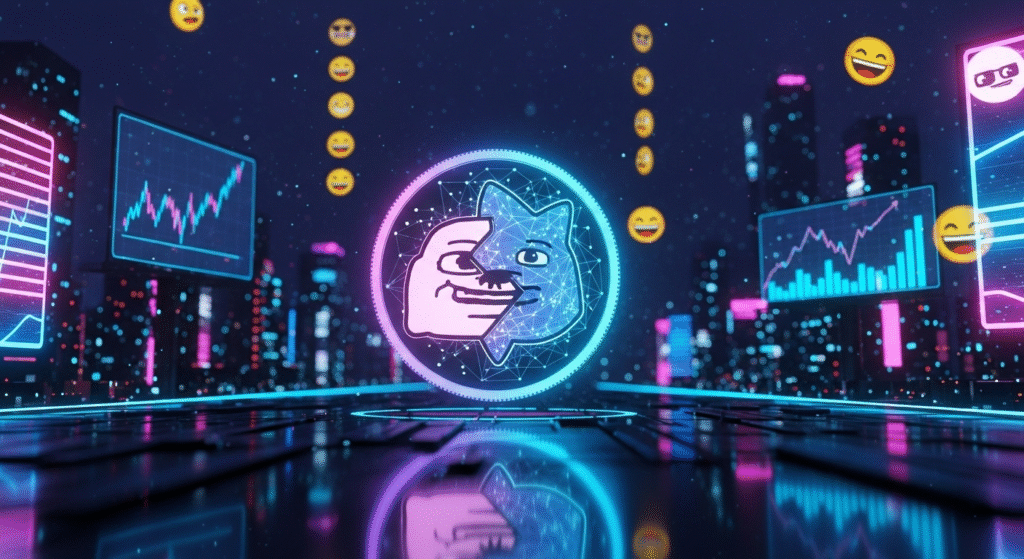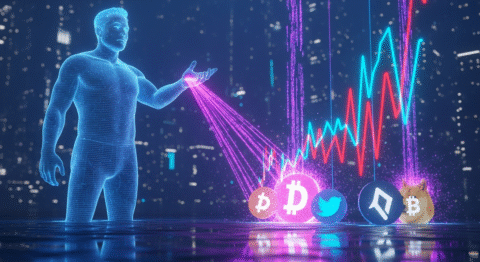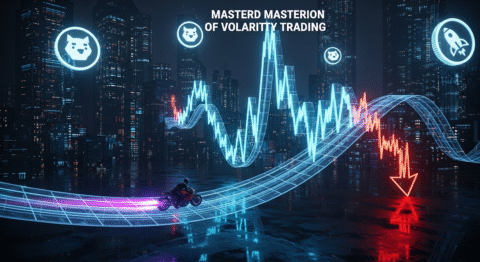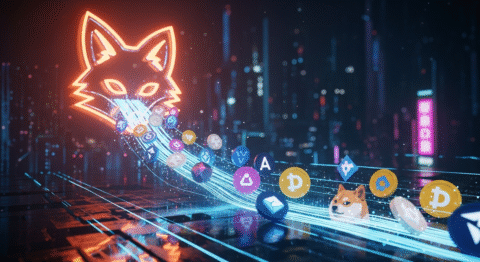.
Metaverse Coins: 5 Secrets for Meme Coin Riches
Can you truly turn a small initial investment into a fortune by strategically investing in Metaverse Coins? In the ever-evolving world of digital assets, the allure of astronomical returns often points towards the volatile yet potentially lucrative realm of meme coins within the vibrant Metaverse. Many are captivated by the stories of early investors who amassed significant wealth, but what are the underlying secrets to navigating this high-stakes game? This article dives deep into the strategies, data-backed insights, and crucial considerations for anyone looking to unlock potential riches within the dynamic landscape of Metaverse crypto.
The cryptocurrency market is a relentless beast, a pulsating ecosystem where fortunes can be made and lost in the blink of an eye. While Bitcoin and Ethereum often dominate headlines, a significant portion of innovation and speculative interest lies within the burgeoning sectors of altcoins, particularly meme coins, and the emerging opportunities presented by airdrops. Understanding the forces that drive these markets is paramount for anyone seeking to capitalize on the next wave of digital asset growth.
Crypto Market Overview
The current cryptocurrency market is a tapestry woven with threads of innovation, speculation, and increasing institutional adoption. We’ve witnessed significant shifts in recent months, with altcoins, in particular, showing remarkable resilience and growth potential after periods of consolidation. Meme coins, once relegated to the fringes, have carved out a significant niche, driven by strong community engagement and viral marketing. Projects leveraging the Metaverse narrative have seen a resurgence, attracting both retail and sophisticated investors eager to bet on the future of decentralized virtual worlds.
Key market indicators suggest a widening interest in utility-driven altcoins that offer tangible solutions within decentralized finance (DeFi) and the ever-expanding Metaverse. Airdrops, a mechanism for distributing tokens, continue to be a popular strategy for new projects to gain traction and reward early adopters, often serving as an accessible entry point for newcomers into the crypto space. Observing these trends, understanding the underlying technologies, and discerning the true potential behind the hype are the first steps toward informed investment decisions.

The Core Concept: How Metaverse Coins Actually Work
At its heart, the concept of Metaverse Coins is intrinsically linked to the broader categories of altcoins and the often-playful world of meme coins, all built upon the foundational technology of blockchain.
What Are Altcoins / Meme Coins / Airdrops?
Altcoins, a portmanteau of “alternative coins,” are essentially any cryptocurrencies other than Bitcoin. They represent a vast and diverse ecosystem, each with its own unique purpose, technology, and community. From smart contract platforms and decentralized finance protocols to privacy-focused currencies and, of course, meme coins, altcoins offer a spectrum of innovation.
Meme coins are a subcategory of altcoins that often originate from internet memes, pop culture references, or social media trends. Unlike many traditional altcoins designed with specific utility in mind, meme coins are frequently driven by community sentiment, virality, and speculative trading. Their value can be highly volatile, often experiencing rapid price surges and corrections. Despite their often lighthearted origins, some meme coins have managed to build substantial communities and even develop underlying utility over time.
Airdrops are a marketing and distribution strategy where new cryptocurrencies or tokens are distributed free of charge to a wide audience, typically to holders of another cryptocurrency or to users who perform specific tasks. Projects use airdrops to generate awareness, attract new users, and decentralize token distribution. For investors, airdrops can be a way to acquire new assets without upfront investment, though discerning valuable airdrops from potential scams is crucial.
Key Components & Technologies
The infrastructure supporting these digital assets is built upon robust blockchain technology. This decentralized, distributed ledger system ensures transparency, security, and immutability of transactions. Underlying many successful Metaverse crypto projects and altcoins are:
- Smart Contracts: These are self-executing contracts with the terms of the agreement directly written into code. They automate the execution of agreements, enabling decentralized applications (dApps), DeFi protocols, and the creation of unique digital assets like Non-Fungible Tokens (NFTs), which are integral to the Metaverse.
- Decentralized Finance (DeFi): DeFi protocols aim to recreate traditional financial services (lending, borrowing, trading) on the blockchain without intermediaries. Many Metaverse projects integrate DeFi elements, allowing users to earn yield on their in-game assets or participate in decentralized governance.
- Interoperability: As the Metaverse expands, the ability for different virtual worlds and platforms to communicate and share assets will become critical. Projects focused on interoperability are laying the groundwork for a truly connected digital universe.
- Tokenomics: This refers to the design and economic principles of a cryptocurrency token, including its supply, distribution, and utility. Well-designed tokenomics are crucial for the long-term sustainability and value appreciation of any digital asset, including those associated with the Metaverse.
The Data-Driven Perspective
To truly understand the potential of Metaverse Coins, we must look beyond the hype and delve into market data and the underlying economic structures of these tokens.
Market Data & Trends
The past year has seen a significant resurgence in interest in Metaverse-related projects. Data from various crypto analytics platforms indicates a steady increase in Decentralized Autonomous Organization (DAO) proposals and transaction volumes within virtual worlds. Notably, gaming-focused Metaverse projects have shown considerable growth, with in-game asset trading and virtual land sales reaching impressive figures.
Meme coins, while notoriously volatile, have also demonstrated surprising persistence. Analyzing on-chain data, we see that community-driven pumps, often fueled by social media sentiment, can lead to exponential price increases. However, these rallies are frequently followed by sharp corrections, highlighting the speculative nature of these digital assets.
Airdrop data also paints an interesting picture. While the number of airdrops has increased, the average value received per participant has seen some dilution. Sophisticated investors are now looking for airdrops from projects with strong underlying technology and active development teams, rather than just high-volume token giveaways.
Tokenomics & Market Health
The tokenomics of Metaverse crypto projects and meme coins are paramount to their long-term viability. Analyzing these aspects can help discern genuine projects from speculative ventures.
- Total Supply & Circulating Supply: A fixed or deflationary supply can, in theory, drive scarcity and price appreciation. Conversely, an ever-increasing supply can put downward pressure on token value.
- Distribution: How tokens are distributed matters. Fair distribution across a wide base of users is generally seen as healthier than a large concentration of tokens held by a few early investors, which can lead to market manipulation.
- Utility & Use Cases: Does the token have a clear purpose within its ecosystem? Can it be used for transactions, governance, staking, or accessing specific services within a Metaverse project? Tokens with strong utility tend to have more sustainable demand.
- Staking & Rewards: Many Metaverse tokens offer staking opportunities, allowing holders to earn passive income while securing the network. This can incentivize long-term holding and reduce selling pressure.
- Inflationary vs. Deflationary Mechanisms: Some tokens employ mechanisms like token burns (destroying tokens) to reduce supply and potentially increase value, while others have inflationary models where new tokens are minted. Each has its own implications for market health.
For meme coins, tokenomics can be more whimsical but still impactful. Factors like transaction taxes (a portion of each transaction is redistributed to holders or burned) and liquidity provision mechanisms on decentralized exchanges greatly influence their trading dynamics. Understanding these structures allows for a more informed assessment of potential risks and rewards.
Risks, Challenges & Competition
Investing in Metaverse Coins, especially meme coins, is not without its significant risks. Awareness of these challenges is crucial for any investor.
Risks of Altcoins and Meme Coins
- Extreme Volatility: Meme coins, in particular, are known for their unpredictable price swings. They can surge astronomically in value based on social media trends or community hype, only to crash just as rapidly. This makes them highly speculative assets, unsuitable for risk-averse investors.
- Lack of Intrinsic Value: Many meme coins are created with minimal underlying technology or utility. Their value is driven almost entirely by speculation and community sentiment, making them susceptible to “rug pulls” where developers abandon the project and flee with investor funds.
- Security Vulnerabilities: The smart contract code underlying any cryptocurrency can have vulnerabilities. Flaws can be exploited by hackers, leading to the theft of funds. Projects with audited code and strong security protocols are generally more trustworthy.
- Regulatory Uncertainty: The regulatory landscape for cryptocurrencies is still evolving globally. New regulations could impact the trading, holding, or usability of certain Metaverse crypto assets, including meme coins.
- Market Manipulation: The relatively low liquidity and high speculative interest in many meme coins make them prime targets for market manipulation, such as pump-and-dump schemes.
- Information Asymmetry: Access to reliable and unbiased information can be challenging, especially for newer projects. Relying on hype and social media without due diligence can be a recipe for disaster.
How Do Metaverse Coins Stack Up Against Competitors?
The Metaverse Coins landscape is a competitive one, with numerous projects vying for attention and investment. Here’s a comparative overview against other emerging digital asset categories:
| Feature | Metaverse Coins (with Meme Coin aspects) | DeFi Tokens | Metaverse Platforms (Native Tokens) | Traditional Stocks |
|---|---|---|---|---|
| Primary Driver | Community hype, speculation, potential Metaverse integration, speculative trading | Utility within DeFi protocols, governance, yield generation | Utility within specific virtual worlds, land ownership, in-game assets | Company’s profitability, industry growth, economic factors |
| Volatility | Very High | High to Moderate | Moderate to High | Moderate to Low |
| Risk Profile | High (potential for scams, rug pulls, extreme price swings) | Moderate to High (smart contract risk, market downturns) | Moderate to High (project adoption, platform stability) | Moderate (market risk, company-specific risk) |
| Underlying Tech | Blockchain, Smart Contracts (often with speculative meme coin tokenomics) | Blockchain, Smart Contracts, Oracles | Blockchain, Smart Contracts, NFTs, AI, VR/AR integration | Publicly traded company’s assets and operations |
| Regulation | Evolving, often less defined for meme coin aspects | Increasing scrutiny, regulatory frameworks emerging | Emerging, depends on specific platform’s utility and features | Heavily regulated |
| Potential Return | Extremely High (but also extreme risk of total loss) | High | High | Moderate |
| Accessibility | Very High (easy to buy on DEXs, often low entry barrier conceptually) | Moderate to High (requires understanding DeFi concepts) | Moderate (requires understanding platform) | Moderate to High (requires brokerage account) |
| Example | Dogecoin (DOGE), Shiba Inu (SHIB), Floki Inu (FLOKI) (while having some utility, started as meme coins) | Uniswap (UNI), Aave (AAVE) | Decentraland (MANA), The Sandbox (SAND), Axie Infinity (AXS) | Apple (AAPL), Microsoft (MSFT) |
This comparison highlights that while Metaverse Coins with meme coin characteristics offer the allure of rapid, high returns, they represent a significantly higher risk profile than more established altcoins or traditional investments. Investing in dedicated Metaverse platform tokens like MANA or SAND, while still volatile, generally offers exposure to a more tangible underlying product and ecosystem.
The Future Outlook
The trajectory of Metaverse Coins, particularly those with meme coin roots, is intrinsically tied to broader trends in cryptocurrency and the development of the Metaverse itself.
What’s Next for Altcoins / Meme Coins / Airdrops?
The future for Metaverse crypto is undoubtedly bright, albeit with continued volatility. As the Metaverse continues to mature, we can expect to see:
- Increased Utility and Integration: Projects that successfully integrate their tokens into functional Metaverse ecosystems, allowing for in-world transactions, governance, and ownership of digital assets, will likely see sustained value. Meme coins that can evolve to offer genuine utility have a better chance of long-term survival.
- Focus on Interoperability: The ability for assets and experiences to seamlessly transition between different Metaverse platforms will be a key determinant of success. Projects focusing on interoperability solutions could see significant adoption.
- Play-to-Earn (P2E) Evolution: The P2E gaming model, often powered by NFTs and associated tokens, is likely to evolve. We may see a shift towards more sustainable economic models that balance entertainment with rewarding gameplay.
- Regulation and Compliance: As the space matures, regulatory frameworks will likely become clearer. Projects that adapt to these regulations will be better positioned for growth.
- Airdrop Sophistication: Airdrops will likely continue, but projects may become more strategic in targeting specific user groups or rewarding contributions to their ecosystem, rather than broad, indiscriminate giveaways. Expect more “utility airdrops” tied to platform usage or participation.
For meme coins, the future is less predictable. Their survival and success will depend heavily on their ability to build and maintain robust communities, adapt to new trends, and, for some, pivot towards offering real-world utility or integration into emerging digital economies. The data suggests that while the speculative frenzy may continue, long-term value will increasingly be driven by demonstrable utility and strong project fundamentals.
Conclusion
Navigating the exciting, albeit high-risk, landscape of Metaverse Coins requires a blend of strategic insight, data-driven analysis, and a healthy dose of caution. We’ve explored the fundamental concepts of altcoins and meme coins, delved into market trends and crucial tokenomics, and highlighted the inherent risks involved.
The allure of meme coin riches is undeniable, but it’s a path paved with volatility and the potential for significant loss. By understanding the importance of utility, community, security, and robust tokenomics, you can make more informed decisions. Remember, the most successful ventures often emerge from projects that combine an engaging community with a clear, sustainable vision.
What are your thoughts on the future of Metaverse crypto? Do you believe meme coins can evolve into sustainable, valuable assets? Share your insights and predictions in the comments below! If you found this deep dive helpful, be sure to subscribe for more insights into the ever-evolving world of cryptocurrency and digital assets. Explore our other articles on [altcoin strategies] and [essential crypto tools] to further enhance your knowledge.
FAQs
1. Are Metaverse Coins safe to invest in?
The safety of investing in Metaverse Coins varies greatly depending on the specific project. While some projects have strong fundamentals and are backed by solid technology, many carry significant risks, especially those with meme coin characteristics that lack intrinsic value or utility. Always conduct thorough research and only invest what you can afford to lose.
2. What is the difference between a Metaverse coin and a meme coin?
While many Metaverse crypto projects utilize tokens that can exhibit meme coin behavior, there’s a distinction. Metaverse coins are typically associated with virtual worlds, gaming, or virtual real estate, aiming to provide utility within these environments. Meme coins, on the other hand, often originate from internet memes or social media trends and derive their value primarily from community hype and speculation, though some are integrating Metaverse elements.
3. How can I find promising Metaverse coins to invest in?
Look for projects with active development, a clear roadmap, a strong and engaged community, and well-defined utility for their token within the Metaverse. Analyze their tokenomics, team background, and any partnerships they have secured. Resources like CoinMarketCap, CoinGecko, and crypto news outlets can be helpful, but always cross-reference information and be wary of excessive hype.
4. What are the biggest risks when investing in meme coins within the Metaverse?
The biggest risks include extreme price volatility, potential for rug pulls (developers abandoning the project), lack of underlying utility leading to a loss of value, susceptibility to community sentiment shifts, and regulatory uncertainty. Their value is often driven by speculation rather than intrinsic worth.
5. Can I earn passive income with Metaverse coins?
Yes, many Metaverse crypto projects offer opportunities for passive income through staking, where you lock up your tokens to support the network and earn rewards. Some Metaverse platforms also allow you to earn through in-game activities, virtual land rentals, or providing liquidity to decentralized exchanges.






